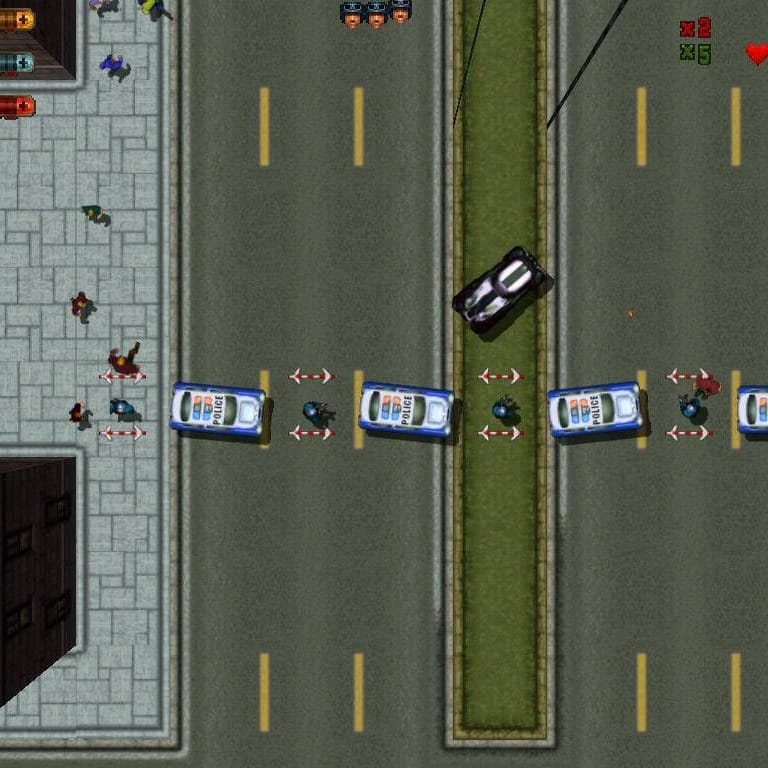Anywhere City Chronicles: Unraveling the Design Anomalies of Grand Theft Auto 2
Was GTA 2's design a tangled mess of themes and visual ideas?

I've been known to wax lyrical about Grand Theft Auto 2 quite a bit.
It wasn't long ago on this website that I pointed out the odd oddity that GTA2 had a rebrand just after launch because of poor sales.
Given that GTA2 is like no other in the series, often referred to as the weirdest, I think it's only fair that we take another look at it.
I think it's also significant in that this is the last 2D top-down Grand Theft Auto before Grand Theft Auto 3 came along, which changed the game if you'll pardon the pun.
Released in 1999 by DMA Design, now known as Rockstar North, Grand Theft Auto 2 marked a significant departure from its predecessor, showcasing a distinctive design and art direction, it was clear that the team wanted to distance themselves artistically from their first effort.
Why did they do it? Well, the reasons aren't well-documented.
A good guess would be that the team was emboldened by the success of the first release, and so wanted to make something that was tonally different to anything they'd done before.
"After the success of the first GTA, people wanted more of the same. But the team at DMA Design (now Rockstar North), displaying a wonderfully anarchic spirit, dreamed up something dark, futuristic, and offbeat instead. " - Andy Kelly, thegamer.com
Subjectively speaking, I admire the team for trying something entirely different aesthetically. The core gameplay was Grand Theft Auto through and through, even with some additional elements such as the respect system.

In the game, seven gangs shape your alliances through gameplay. Upsetting the Zaibatsu Corporation closes job opportunities, but the rival Loonies appreciate it, offering tasks.
To rekindle ties with Zaibatsu, one could target the Loonies. Real-time meters tracked these relationships, creating a dynamic, responsive world.
It was an intriguing system and one that would act as a precursor for gang relationships in gaming.
The game's wanted system was also expanded and introduced escalating levels of law enforcement response, from police chases to the mobilisation of the National Guard at six wanted levels.
20 Minutes Into the Future

Though the game brought in new gameplay elements, it was the visual style that divided the fan base.
The game shifted from the "realistic" urban settings of New York, San Francisco, and Miami to the entirely fictional Anywhere City. A city that was less relatable but more intriguing in its otherworldly charm.
This retro-futuristic metropolis was a visual departure, embracing a bleak, dystopian atmosphere inspired by '70s and '80s cult cinema.

It felt like it captured a city just "20 minutes into the future," presenting a nuanced blend of familiar elements and speculative futures that defined its unique aesthetic and narrative allure.
However, the familiar elements were heavily criticised on release, with IGN's Tal Blevins calling them "average at best", and that the scenery is "hard to appreciate".
Well, Tal Blevins, I disagree.
While the initial GTA heavily recycled assets in its three cities, Anywhere City's diverse regions stand out visually.
It may not be considered a beautiful game, especially by today's standards, but it's undeniably intriguing to see visual differences as you drive through the relatively expansive city.
Rockstar Radio
Noteworthy are the 11 tongue-in-cheek radio stations, a precursor to the satirical humour later perfected by the series, but not the first time as demonstrated in the series.
Listening to the soundtrack for this while I'm on a walk, and it's a trip.
— PlayStation Polygons (@PSPolygons) September 6, 2023
It feels otherworldly because, well, it's obviously a satirical take on American culture for a completely fictional world.
It straddles a fine line between US daytime radio and making a mockery of it.
Commercials advertising fictional products like 'Orgasmo chocolate bars and 'Lad Rover SUVs showcased early signs of the humour that would become a series staple.
If you ask any fan about their best memory from GTA1 or 2, they'll likely bring up the radio.
The music was made by Rockstar themselves since famous artists either didn't want to associate their name with such a controversial title, or due to budgetary reasons.
Likely both, though.
This worked in Rockstar's favour as it gave the games a more special, unique quality. The content was genuinely original and funny, showcasing what was to come for later GTA releases.
Was GTA 2's design a tangled mess of themes and visual ideas?
I would say it was rather cohesive in its design language, but that it was the design language itself that made it misunderstood. The fact that they had to redesign the artwork after launch is a testament to this misunderstanding.
Sure, it's the weirdest, most offbeat game in the series, but that should be embraced. There are moments within that have inspired Grand Theft Auto to become the juggernaut it is today.
Who knew that just two years later we'd see the release of Grand Theft Auto 3?
A practical leap through time and a groundbreaking moment not just for the series, but for the entire gaming industry.
While GTA2 may not match today's standards, its influence on the series and its unique design makes it a fascinating snapshot of Rockstar's earlier creative endeavours, and I'm thankful it exists.
Correction: Thanks to @SavagedRegime for pointing out that the original piece that plays during the intro wasn't composed by the team at Rockstar. It's a track called Rhythm composed by Engineers Without Fears.




Comments ()